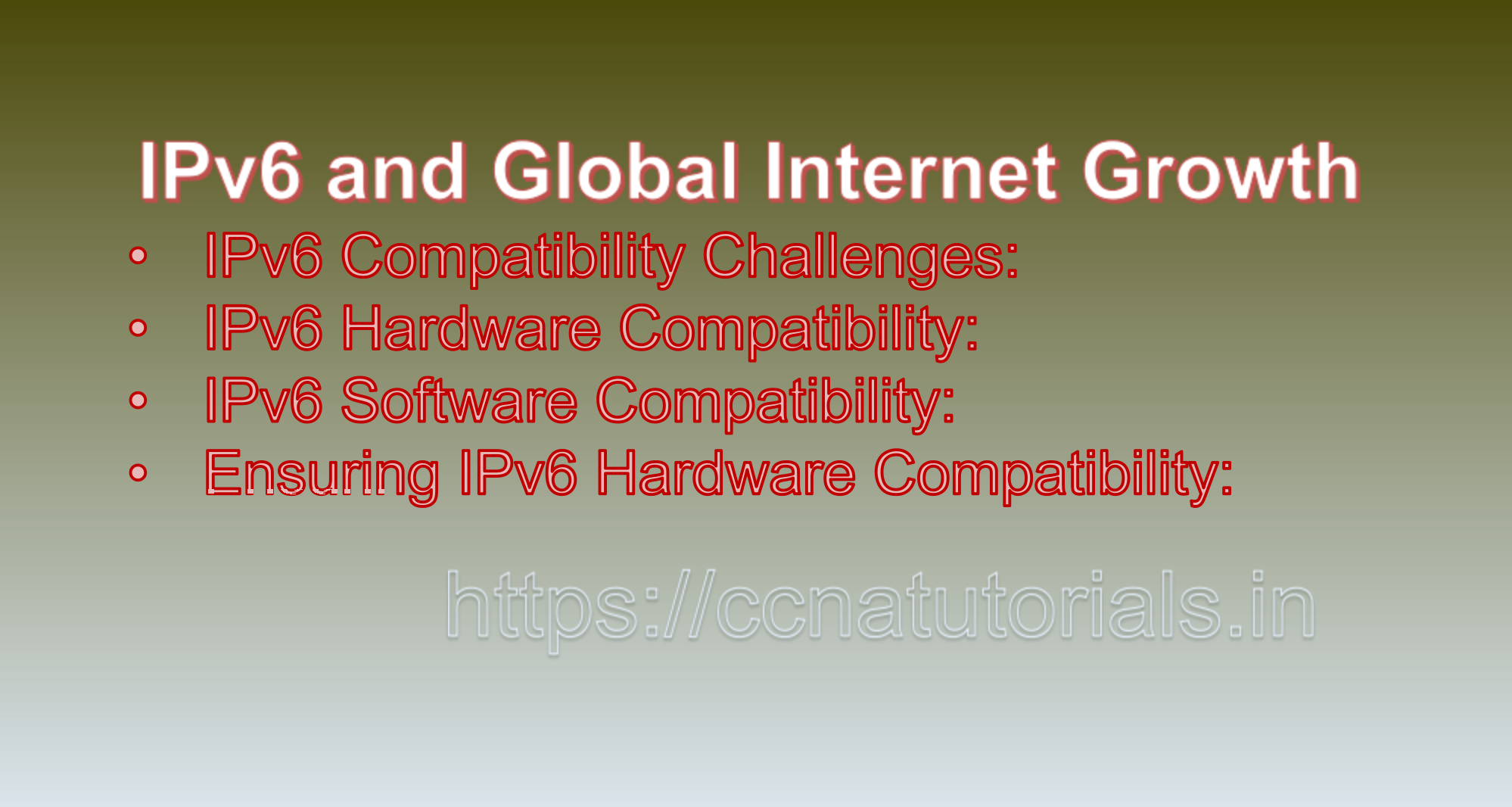Contents of this article
In this article, I describe IPv6 Hardware and Software Compatibility: Ensuring Seamless Transition to the Next-Generation Protocol. The transition from Internet Protocol version 4 (IPv4) to Internet Protocol version 6 (IPv6) is driven by the need for an expanded address space and improved functionality in the evolving digital landscape. While IPv6 brings numerous benefits, including a vast address pool and enhanced security features, the compatibility of both hardware and software with IPv6 is a crucial consideration. This article delves into the significance of IPv6 hardware and software compatibility and provides examples of how organizations can ensure a smooth transition to IPv6 without disrupting their existing network infrastructure.
1. IPv6 Compatibility Challenges:
Transitioning to IPv6 involves ensuring that both hardware devices and software applications support the new protocol. Legacy equipment and applications designed for IPv4 may face challenges in accommodating IPv6’s longer address format and different header structure. Ensuring compatibility is essential to prevent disruptions, maintain network functionality, and leverage the benefits of IPv6.
2. IPv6 Hardware Compatibility:
IPv6 hardware compatibility refers to the ability of network devices and equipment to support IPv6 addressing and communication. Hardware components must be capable of processing IPv6 packets and routing traffic efficiently. Common networking devices that require IPv6 compatibility include routers, switches, firewalls, and network interface cards (NICs).
3. IPv6 Software Compatibility:
IPv6 software compatibility pertains to applications, operating systems, and networking software’s ability to function seamlessly with IPv6. Software must be capable of recognizing and processing IPv6 addresses, protocols, and headers. Applications that interact with network data, such as web browsers, email clients, and servers, need to support IPv6 to ensure uninterrupted communication.
4. Ensuring IPv6 Hardware Compatibility:
– Firmware Updates:
Many hardware vendors release firmware updates that enable IPv6 support on their devices. Organizations should regularly check for and apply these updates to ensure compatibility.
– Hardware Refresh:
In cases where legacy hardware lacks IPv6 support, organizations may need to consider hardware replacement or upgrades to ensure compatibility with the new protocol.
5. Ensuring IPv6 Software Compatibility:
– Operating System Updates:
Operating system vendors regularly release updates that enhance IPv6 compatibility. Keeping operating systems up to date ensures that software can effectively communicate over IPv6.
– Application Updates:
Developers should update applications to ensure they can recognize and process IPv6 addresses and protocols. This is crucial for maintaining seamless communication between applications and network resources.
6. Example: Ensuring IPv6 Compatibility in a Corporate Environment:
A multinational corporation is preparing to transition its network infrastructure to IPv6. The IT team focuses on ensuring hardware and software compatibility to prevent disruptions.
Implementation:
– The team conducts a thorough assessment of routers, switches, and firewalls to verify IPv6 support and update firmware where necessary.
– They evaluate the organization’s operating systems and applications, ensuring that all are updated to versions that offer robust IPv6 compatibility.
Benefits:
– The organization’s network experiences a smooth transition to IPv6 without any major disruptions or communication breakdowns.
– Employees continue to use applications and services seamlessly, irrespective of whether IPv4 or IPv6 is used for communication.
– The IT team’s proactive approach to ensuring compatibility minimizes downtime and avoids potential service disruptions.
7. IPv6 Compatibility Testing:
To ensure a successful transition, organizations can perform compatibility testing in a controlled environment. This involves testing hardware devices, software applications, and network configurations to identify and address potential issues. Compatibility testing helps ensure that the existing network infrastructure and services will continue to function seamlessly after the transition to IPv6.
8. IPv6 Transition Mechanisms:
To bridge the gap between IPv4 and IPv6 during the transition phase, various transition mechanisms are available. Examples include:
– Dual-Stack:
Running both IPv4 and IPv6 on the same network devices and systems allows for a gradual transition, ensuring compatibility with both protocols.
– Tunneling:
Tunneling mechanisms encapsulate IPv6 packets within IPv4 packets, enabling communication between IPv6-enabled endpoints over an IPv4 network.
– Translation:
Network Address Translation (NAT) mechanisms allow IPv4-only devices to communicate with IPv6-only devices by translating between the two protocols.

In short IPv6 Hardware and Software Compatibility, Seamlessly Embracing IPv6
IPv6 hardware and software compatibility are crucial for a successful transition to the next-generation protocol. Ensuring that network devices, operating systems, applications, and services support IPv6 is essential to prevent disruptions, maintain network functionality, and leverage IPv6’s benefits. By updating firmware, refreshing hardware where necessary, and ensuring software compatibility, organizations can ensure a smooth transition to IPv6 and future-proof their network infrastructure. Compatibility testing and the utilization of transition mechanisms further contribute to a seamless migration, enabling organizations to embrace the potential of IPv6 while maintaining a robust and efficient network environment.
IPv6 Hardware and Software Compatibility: Enabling Seamless Transition and Interoperability
The adoption of Internet Protocol version 6 (IPv6) is essential to address the address exhaustion challenges of its predecessor, IPv4. As organizations migrate to IPv6, ensuring compatibility between hardware and software components becomes a critical consideration. IPv6 compatibility refers to the ability of networking equipment, operating systems, applications, and services to work seamlessly in an IPv6-enabled environment. This article explores the significance of IPv6 hardware and software compatibility and provides examples of how organizations can ensure a smooth transition to IPv6.
1. The Need for IPv6 Compatibility:
IPv6 introduces fundamental changes compared to IPv4, including an expanded address space, simplified header format, and mandatory support for features like Internet Protocol Security (IPsec). As organizations adopt IPv6, they must ensure that their existing hardware and software infrastructure are compatible with the new protocol to avoid disruptions and maintain a functional network environment.
2. Key Components of IPv6 Compatibility:
– Network Equipment:
Routers, switches, firewalls, and other networking devices must be capable of processing IPv6 packets and routing them correctly.
– Operating Systems:
Operating systems running on computers, servers, and mobile devices need to support IPv6 addressing, routing, and related protocols.
– Applications:
Applications and services that rely on IP-based communication must be compatible with IPv6 addresses and be able to communicate over IPv6 networks.
– Security:
IPv6 compatibility also extends to security measures such as firewalls, intrusion detection systems, and virtual private networks (VPNs), which must be configured to handle IPv6 traffic securely.
3. IPv6 Hardware Compatibility Example:
– Router Compatibility: A business is upgrading its network infrastructure to support IPv6. The organization ensures that its existing routers are capable of handling IPv6 routing protocols, forwarding packets, and managing both IPv4 and IPv6 traffic. If the routers lack IPv6 compatibility, the organization might need to consider upgrading to newer router models that support the protocol.
4. IPv6 Software Compatibility Example:
– Operating System Upgrade: A university is planning to enable IPv6 on its campus network. Before doing so, the IT department assesses the compatibility of its various operating systems with IPv6. They discover that most of the operating systems used on campus are already IPv6-compatible and require only minor configurations to enable IPv6 addressing and routing.
5. Ensuring IPv6 Compatibility:
– Vendor Documentation:
Hardware and software vendors typically provide documentation outlining the IPv6 compatibility of their products. Organizations should consult these resources to understand which components require updates or adjustments.
– Firmware and Software Updates:
Vendors may release firmware updates for network devices or software patches for operating systems to add or improve IPv6 compatibility. Staying up-to-date with these updates ensures a smooth transition to IPv6.
– Testing and Piloting:
Before rolling out IPv6 on a large scale, organizations can conduct testing and pilot deployments in controlled environments. This approach helps identify compatibility issues and allows for adjustments before widespread implementation.
6. Case Study: Enterprise IPv6 Compatibility Assessment:
A multinational corporation is preparing to transition to IPv6 across its global network. To ensure a smooth migration, the IT team conducts a comprehensive compatibility assessment.
Implementation:
– The team reviews vendor documentation to understand the IPv6 compatibility of routers, switches, firewalls, and other networking equipment.
– Operating systems and software applications are tested in a lab environment to verify their IPv6 compatibility and to identify any necessary adjustments.
Benefits:
– The corporation identifies specific hardware and software components that require updates for IPv6 compatibility.
– By conducting pilot deployments and testing, the IT team addresses compatibility issues early, reducing the risk of disruptions during the full deployment.
Conclusion for IPv6 Hardware and Software Compatibility, Paving the Way for a Seamless Transition:
IPv6 compatibility is a crucial aspect of successful IPv6 adoption. Ensuring that networking hardware, operating systems, applications, and security measures are compatible with IPv6 enables organizations to transition smoothly without compromising network functionality or user experience. By referring to vendor documentation, staying updated with firmware and software releases, and conducting thorough testing, organizations can confidently embrace IPv6 while maintaining interoperability and operational continuity. As the internet continues to evolve and expand, IPv6 compatibility remains a key enabler of a robust and future-ready network infrastructure.






